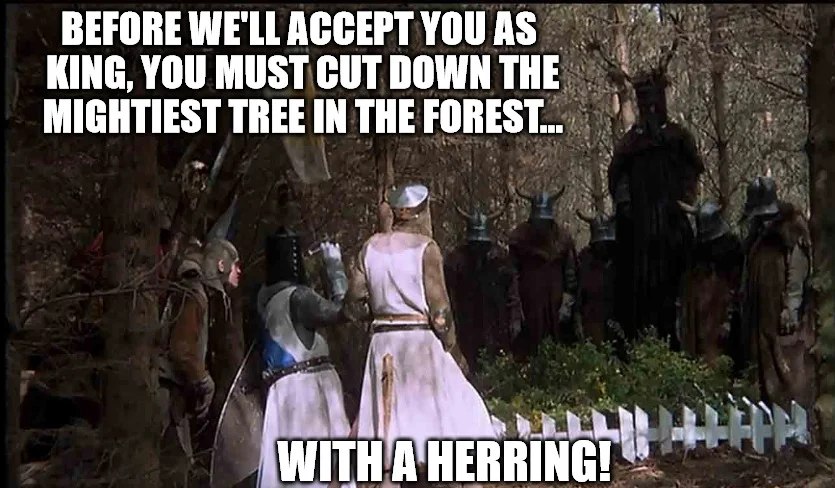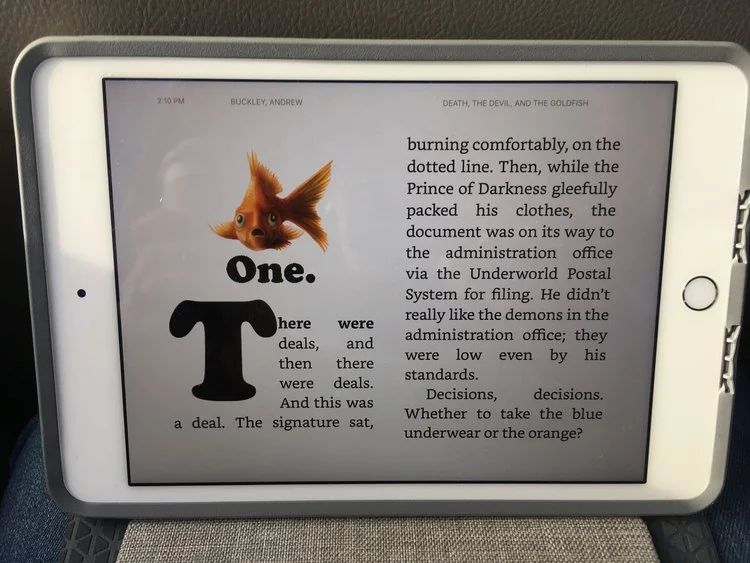Writer's Life - Writing a Book Blurb
I've heard a lot of my fellow authors bemoan the process of writing up a book blurb, and with good reason. Sorry. You want me to what? Encapsulate an entire book in just a few lines, while not spoiling anything and making it interesting? No, really interesting. Not to mention that ever-elusive, five second elevator pitch. That's sounds like the kind of quest the Knights Who Say Ni would make up.
Credit: Sony Pictures
Right?! While no one really knows the "secret" to marketing (because there isn't one), and while there's no one "right" way to do it, writing a catchy* book blurb can be broken down into a process**. First, though, allow me to encourage you to do more research once you're done reading this post. There are tons of fantastic resources out there for writers struggling with this very thing. Just Google "help me write a book blurb" and you'll get more articles than you have time to read. My preferred list of additional resources can be found at the end of this post.
*What's catchy to one person won't be catchy to another, so have several different pitches formed in your head when going to live events. For instance, if someone tells me they like paranormal, you can bet I mention that my books feature a couple of vampires. As for your general book blurb (like the one you put on Amazon) focus on the best high points.
**In short, you're looking to blend the familiar (something people can easily connect with) with the unknown (something interesting they haven't seen before).
~PRE BLURB WRITING RESEARCH~
Know Your Different Pitches ~ Do not confuse a book synopsis with a blurb. A blurb (sometimes also called a description) is what you find on the back of a book or on the book's Amazon page to suck you in as a reader and should be spoiler free. A synopsis tells the reader in short form what happens from start to end in the book. The synopsis a highly specialized tool you create for querying agents, including in press kits, etc. And we're not gonna talk about that today. After that there's your elevator pitch. No more than five seconds long, this should just give a reader a taste of what your book is like or about.
Define Your Audience ~ No offense, but if a bookseller asks you, "Who is your book's audience?" and you respond, "Everyone!" you've already stumbled at the starting line. Competition in the book world is tight. Even if your book is ridiculously awesome, it's still floating in a sea of millions of other books, and trying to advertise to everyone will spread your efforts so thin as to be ineffective. Plus, the booksellers need to know where to shelve your book. Yes, Harry Potter is popular across almost all demographics, but it's categorized in Amazon and shelved in most stores under Children's Books. So think about who buys your books the most and under what category you're listing it on Amazon and/or IngramSpark.
Look at Similar Examples ~ Right, now that you've defined your audience and have a good idea of where your book lives on shelves, look at some blurbs for books that are like yours/in the same genre. This should only provide you with a rough guide as to how to write your blurb; never, ever plagiarize! I feel like I shouldn't even have to say that, yet here we are. And that being said, let's flip the script and move onto the next step.
Avoid Cliches ~ Tropes! People sure do like to hate on them. I personally don't mind repeating tropes as long as it's not the same old thing I've read before. Is your main character at the center of a prophecy? Okay, that's fine, but you have to realize that's been done a bajillion times before, and you need to tell potential readers why your book is different, so take some time to figure that out. Is your book a Beauty and the Beast retelling? Cool, but what makes this version different from the gads of other B&tB retellings out there? It's a genderbent version set on Mars. Oh, okay! Lead with that as you mention it's a retelling! Like I said above, you're looking to blend the familiar with the new.
So now you know the difference between a synopsis, a blurb, and an elevator pitch; you've defined your audience; looked at similar examples; and figured out what makes your book baby unique. Awesome! Let's write the thing!
~WRITING THE BLURB~
Communicate Through Voice ~ The tone of your synopsis should match the tone of your book. If your book is funny, so should be your blurb. I really love the first few lines from Andrew Buckley's blurb for Death, the Devil, and the Goldfish.
"From the Bahamas to Heathrow airport, to the rain soaked streets of London the dead have ceased dying. This is inconvenient for a number of reasons but what’s the real reason behind the chaos?"
The choice to describe this phenomenon as merely "inconvenient" matches the tone of the book so well. It's wry, sardonic, and hilarious. Whatever's in you that made you write your book with the tone you did, use that to write your blurb too.
Trust in Your Readers ~ This is hard when you're writing your book, and I think it's fair to say we all struggle with how much we feel like we need to explain to them. Well, there's next to no room in your blurb for explaining stuff, so you're either going to have to leave explanations out altogether or think up a very clever, succinct way to do it. If your book is fantasy, don't waste time explaining what a centaur is or telling people it doesn't take place in our world. We defined our audience for a reason, and if your defined audience are fantasy lovers, they're already going to know those things because they're familiar with the genre.
One Hook, Two Jobs ~ Remember that elevator pitch I mentioned? The first line of your blurb could be that. Different people have different theories on this, and I'm not even sure where I land in the argument. Again, though, there's no one "right" way to write a book blurb, so you could introduce your book with the elevator pitch. For that idea I mentioned before, you really could just say, "A genderbent Beauty and the Beast set on Mars." If you can't think of anything really hooky, though, I'd advise you not to use this method. Don't waste precious time on something that's only meh.
That being said, you do want your first paragraph at least to give kind of a general overview of the book. Use strong language here, define big risks, and highlight what's really interesting in the book to make the readers curious.
The Actual Blurb ~ Hopefully, your first paragraph piqued enough curiosity to keep people reading. The second paragraph is where you explain the real meat of the story in more detail. Here is where you define your main character or characters and their problems more closely. You might even describe your inciting incident here, the thing that set everything off in the first place. And don't for a second let readers think it'll all be fine. No! You want drama! Point out the stakes and why it's gonna be so hard to fix the aforementioned problem. You can even go so far as to ask a question about the story because that might put the same question into your potential readers' heads.
Who's In Your Book's Circle? ~ Some people don't do this, but I prefer to. Once again, I want to give people some kind of a touch point. In my last paragraph, I always zoom back out and give readers a more general idea of what this book is like. I usually say something to the effect of, "For fans of [enter appropriate author here]..." so readers know whose books my book resembles. You could also say something like, "If this person and that person's books had a baby, you'd get [enter book name here]." Give them some frame of reference they'll likely already know. The "Customers also bought..." and "Sponsored products related to this item..." areas on an existing book page can point you to similar books.
You can also slip in any useful keywords you haven't yet been able to. For instance, if you were describing the show Firefly, you might tell someone it's Old West meets East meets Space. Do the same thing for your book if that's a selling point. Again, this is something that makes your book unique or interesting, but use this section sparingly. It's not a dumping ground; it's to hone the end of your pitch to a fine point.
Short and Sweet ~ Your book blurb should be snappy. Some guide suggest less than 5k words. Some say less than 300! Talk about brief! Again, look at the length of the descriptions for similar books and use that as a guide.
(Optional) Break It Up ~ This is a stylistic choice that can really help create effect. For instance, Sarina Langer's forthcoming book, Darkened Light, has four characters the story follows. That's a lot of ground to cover, so she's got a separate line to describe the struggle each one faces, and I really like the effect it creates. That may not work for you, though, which leads me to my final tip.
Workshop, Tweak, Workshop Again ~ Writing a good book description is hard! It takes a lot of work, just like writing and editing the book did. So, just like you did with your book, get feedback, have other people look at it. Give them questions like you would beta readers - what parts really jump out and grab you? What do you feel is unnecessary? Keep working at it until it's awesome. You want your blurb to tell readers just how great your book is, so work it, fix the weak spots, and work it some more.
As I mentioned above, there are gobs of resources out there. These are just a few of my favorite articles, all written by some major players in the industry to help you create a great book description. Barnes and Noble, Ingram Spark, KDP, and CreateSpace. If you know of some more, feel free to include them or any other tips you have in the comments below.
Thanks for reading!


